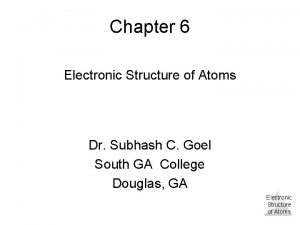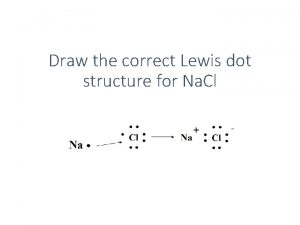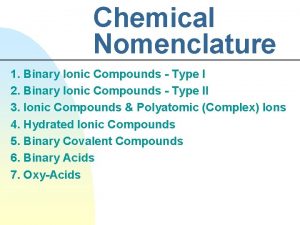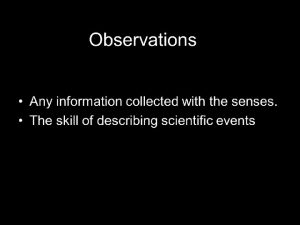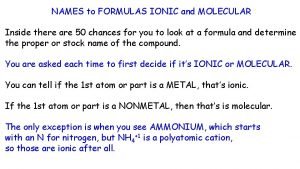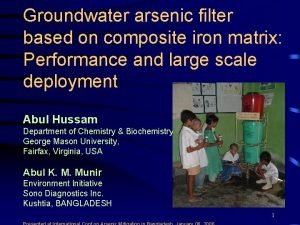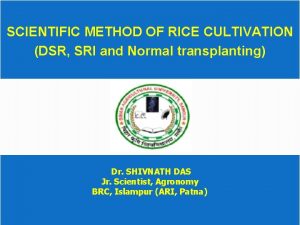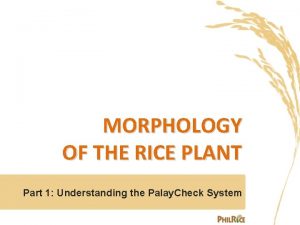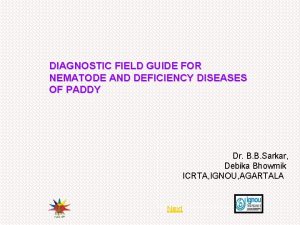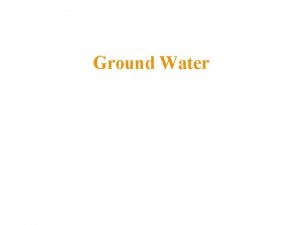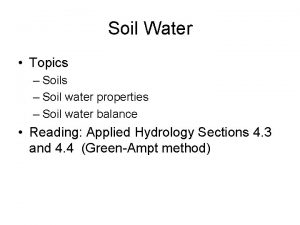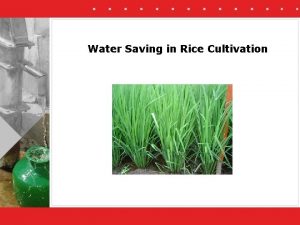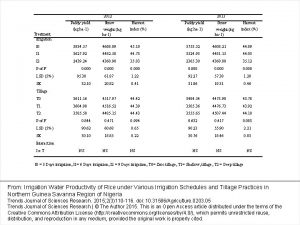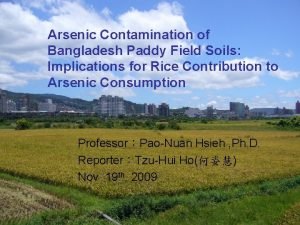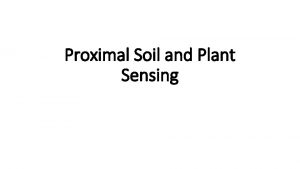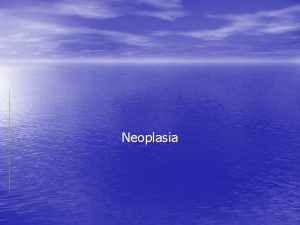Ground water Arsenic paddy soil and rice plant




![Species : q q Arsenite [As(III)], Arsenate [As(V)], Monomethylarsonate (MMA) Dimethylarsinate (DMA). Name Formula Species : q q Arsenite [As(III)], Arsenate [As(V)], Monomethylarsonate (MMA) Dimethylarsinate (DMA). Name Formula](https://slidetodoc.com/presentation_image_h2/4520d72499ee156945446063db45bb0e/image-5.jpg)
















- Slides: 21

Ground water Arsenic, paddy soil and rice plant Dr. B. K. Medhi Senior Scientist (Soil) AICRP on Water Management Assam Agricultural University, Jorhat, Assam

Why Arsenic pollution is overlooked in groundwater • Arsenic enters our water systems from more than just the rocks and minerals that contain it, but now increasingly from industrial waste. • Much emphasis about our water quality was placed on the amounts of chlorine or nitrates and phosphates present in our water. • Many people still do not realize that arsenic pollution in water is creating serious problems across the world and should not be ignored any longer.

Arsenic Information • Arsenic is a semi-metal with an atomic number of 33. • It is odorless and tasteless, and is naturally occurring in rocks and soil. • Arsenic can be combined with other elements to make chemicals that are used to preserve wood or as insect killers on cotton crops. • Organic arsenic which is mainly found in seafood, is harmless to the human body.

Naturally occurring in the Earth's crust and widely dispersed in the environment, arsenic is the 20 th most abundant element. Sources of arsenic contamination q q Arsenopyrite or mispickel (Fe. As. S), Realgar (As. S), Lollingite (Fe. As 2, Fe. As 3, and Fe. As 5) Orpiment (As 2 S 3). These minerals are usually associated with sulfide ores or other metal ores and act as a major starting point for the introduction of arsenic into the environment.
![Species q q Arsenite AsIII Arsenate AsV Monomethylarsonate MMA Dimethylarsinate DMA Name Formula Species : q q Arsenite [As(III)], Arsenate [As(V)], Monomethylarsonate (MMA) Dimethylarsinate (DMA). Name Formula](https://slidetodoc.com/presentation_image_h2/4520d72499ee156945446063db45bb0e/image-5.jpg)
Species : q q Arsenite [As(III)], Arsenate [As(V)], Monomethylarsonate (MMA) Dimethylarsinate (DMA). Name Formula Arsenite As(OH)3 Arsenate As. O(OH)3 Monomethylarsonic acid CH 3 As. O(OH)2 Dimethylarsinic acid (CH 3)2 As. OH Arsenobetaine (CH 3)3 As+CH 2 COO The inorganic forms (As 3+ and As 5+) are mainly present in groundwater and in oxidizing condition As 5+ is predominant species and in reducing condition as As 3+ is the predominant species.

Poisonous Arsenic • The arsenic that concerns scientists is inorganic arsenic that pollutes the groundwater. Despite its high toxicity, inorganic arsenic occurs naturally on earth in small amounts. • Inorganic arsenic is a known and documented carcinogen, leading to skin, lung, liver, bladder, kidney, and prostate cancer. • Inorganic arsenic is one of the most toxic substances in its purest form, and besides cancer as a long term effect, it can cause infertility, decreased production of red and white blood cells, and can even damage DNA.

How are we exposed to it? • Since arsenic is widely distributed throughout the earth’s crust, it is introduced into the water through the dissolution of minerals and ores. • Industrial waste also contributes to arsenic pollution when run-off from orchards where arsenic is used mixes with the groundwater. • The combustion of fossil fuels also pollutes the environment with arsenic through atmospheric deposition when water from rains brings the arsenic to the ground.

Effects of Arsenic poisoning • Arsenic poisoning is different from acute poisoning, and results from a chronic and long term exposure to arsenic which produces symptoms over time. • The main symptoms of arsenic exposure include stomach pain, diarrhea, vomiting, nausea, numbness in hands and feet, thickening and discoloration of the skin, partial paralysis, and blindness.

Backround : ü Groundwater arsenic pollution has generated interest both in the political and legal domains as well as scientific world. ü Arsenic contamination in groundwater in Assam has become an serious concern vis-à-vis its use for irrigation purposes. ü Even if arsenic-safe drinking-water is assured, the question of irrigating soils with arsenicladen groundwater will continue for years to come. ü Immediate attention should be given to assess the possibility of accumulating arsenic in soils through irrigation-water and its subsequent. entry into the food-chain through rice. ü The most important action in affected communities is the prevention of further exposure to arsenic by provision of a safe water supply.

ü Irrigating a rice field with groundwater containing 0. 55 mg/L of arsenic with a water requirement of 1, 000 mm results in an estimated addition of 5. 5 kg of arsenic per ha per annum ü GIS based technology will allow viewing, understanding questions, interpreting, and visualizing arsenic vulnerability risk zone.

Total rice production of Assam : 50 lakh tonnes (approx. ) 250 kg of Arsenic is added for consumption Rice Arsenic content : 0. 05 mg/kg Rice contributes significantly to arsenic exposure of humans through the diet, because arsenic is mobilized from paddy field soils and accumulated by the rice plant. Arsenic in the rice grain is dominated by inorganic arsenic depends on many factors, such as plant genotype, soil type, water management and so on. Total population : 3, 11, 69272 EPA <5 ppb/day) 0. 022 mg per day (0. 044 mg/kg/day = 44 ppb/day


Problem identified : Irrigating rice with Arsenic contaminated groundwater has far-reaching consequences because of its highest accumulation in grain crop under reduced environment. Status of Arsenic contamination (μg/ml) in ground water Villages Nagajanka Bacha Bihari Gaon Garmuria Gaon GPS points (DD & DD) 26. 6270250000 26. 6249194444 26. 6177666667 26. 6261833333 26. 6217638889 26. 6216250000 26. 3724388889 26. 3812250000 27. 0435861111 27. 0447805556 27. 0437416667 27. 0409361111 27. 0485944444 27. 0409861111 27. 0668694444 27. 0660805556 27. 0640527778 27. 0673083333 94. 1964722222 94. 1760805556 94. 1924777778 94. 1931777778 94. 1720055556 94. 1888138889 94. 1378222222 94. 1586750000 94. 3242222222 94. 3266055556 94. 3296027778 94. 3238277778 94. 3275722222 94. 3272638889 94. 2333305556 94. 2326916667 94. 2315500000 94. 2319361111 As 0. 095 0. 048 0. 063 0. 049 0. 113 0. 087 0. 039 0. 059 0. 063 0. 074 0. 072 0. 067 0. 077 0. 066 0. 037 0. 051 0. 057 0. 043 67% water samples contain As level above the guideline value of NDW

Katani Gaon 26. 6037250000 94. 1925638889 0. 119 26. 5882750000 94. 2042611111 0. 101 26. 5920527778 94. 1898972222 0. 096 26. 5961694444 94. 2158416667 0. 089 26. 5946388889 94. 1932027778 0. 079 26. 5926555556 94. 1975500000 0. 107 Kathkatia Gaon 26. 5040555556 94. 2166777778 0. 036 26. 5247416667 94. 2438361111 0. 043 26. 5525861111 94. 2608944444 0. 044 26. 5379111111 94. 2210111111 0. 047 26. 5277333333 94. 2462833333 0. 029 26. 5020250000 94. 2245277778 0. 041 Deka Gaon 26. 5418611111 94. 1767527778 0. 053 26. 5428361111 94. 1735027778 0. 038 50% collected water samples showed As level above the guideline value of NDW 26. 5408916667 94. 1607805556 0. 029 26. 5459388889 94. 1745472222 0. 056 26. 5447388889 94. 1723972222 0. 042 Borera Gaon 26. 5488083333 94. 1787527778 0. 055 Borera Gaon 26. 6261666667 94. 3560555556 0. 041 Deka Gaon 26. 6086666667 94. 3620000000 0. 068 26. 6199388889 94. 3386944444 0. 063 Kathkatia Gaon 26. 6087222222 94. 3260305556 0. 044 26. 5995305556 94. 3297805556 0. 059 26. 6383638889 94. 3292527778 0. 039 Katani Gaon 0 0, 05 0, 1 Arsenic concentration (μg/ml) 0, 15



Effectiveness of Arsenic Water Treatment Methods* TREATMENT TECHNOLOGY Iron Coprecipitation Alum Coprecipitation “ “ “ Lime Precipitation “ “ “ Activated Alumina “ “ “ Ion Exchange “ Reverse Osmosis “ Electrodialysis Sulfide Precipitation Activated Carbon INITIAL ARSENIC CONCENTRATIO N Oxidized Arsenic 56 mg/L Arsenate 350 µg/L Arsenite 350 µg/L Arsenate 560 µg/L Arsenate 300 µg/L Arsenite 300 µg/L Arsenate 350 µg/L Arsenite 350 µg/L Arsenate 300 µg/L Arsenite 300 µg/L Arsenate 500 mg/L Arsenite 500 mg/L Arsenate 2 mg/L Arsenite 2 mg/L Arsenate 100 µg/L Arsenite 100 µg/L Arsenate 57 µg/L Arsenite 31 µg/L Arsenate 100 mg/L Arsenate 68 mg/L Arsenite 37 µg/L Arsenate 51 µg/L Arsenite 188 µg/L Arsenate 132 mg/L Arsenite 500 µg/L FINAL ARSENIC CONCENTRATION* 10 µg/L 6 µg/L 140 µg/L 10 µg/L 6 µg/L 138 µg/L 74 µg/L 263 µg/L 30 µg/L 249 µg/L 4 mg/L 20 µg/L 160 µg/L 4 µg/L Ineffective ND at p. H 6. 0 Ineffective < 800 µg/L 12. 2 to 0 mg/L 7 µg/L 1. 5 µg/L 136 µg/L 26 mg/L 300 µg/L REFERENCES Brewester 1992 Logsdon 1974 Shen 1973 Sorg 1978 Logsdon 1974 Sorg 1978 Nishimura 1985 Frank 1986 Clifford 1991 Vance Calmon 1973 Clifford 1991 Rosehart 1972

How Arsenic pollution can be prevented • So far, no filtration technique has been proven to be effective in all types of situations in removing arsenic. • As scientists continue to lower the concentration of arsenic in the water that is accepted, the cost and difficulty to get it that low is increased. • Although we cannot truly prevent arsenic from being in our water because it is a naturally occurring element, we can reduce the amount • Some of the simple and low cost techniques to remove arsenic at the household level are passive oxidation, SORAS, oxidation and coagulation by KMn. O 4 and sodium/Ca hypocholoride & Ferric chloride/Ferric sulphate, some filters

CONCLUSIONS Ø The behavior of arsenic in groundwater and industrial wastewater is dominated by redox and p. H conditions. Under a limited range of specific Eh/p. H conditions there exists the ability to predict total immobility of arsenic in groundwater and in water treatment systems. Except for those conditions arsenic will be partially mobile, the magnitude of which is difficult to predict. Implications of this behavior include: Ø Arsenic treatment without control of Eh/p. H is likely to be ineffective. Ø In situ remediation via recovery or stabilization of arsenic contaminated groundwater should be focused on Eh control through chemical or biological methods. Ø Use of activated carbon in reducing arsenic level is gaining momentum nowadays.


Thank you
 Electron configuration rules
Electron configuration rules Ground state of arsenic
Ground state of arsenic Water and water and water water
Water and water and water water Sophomoric humor meaning
Sophomoric humor meaning Crop calendar for rice
Crop calendar for rice S22- lewis structure
S22- lewis structure Lewis structure for arsenic
Lewis structure for arsenic Binary compound
Binary compound Self sealability test for rubber closures
Self sealability test for rubber closures Valentin ross german chemist
Valentin ross german chemist Formula for arsenic pentabromide
Formula for arsenic pentabromide I atomic radius
I atomic radius Shorthand electron configuration for arsenic
Shorthand electron configuration for arsenic Ionic
Ionic Sono arsenic filter
Sono arsenic filter A fur coat summary
A fur coat summary Sabour shree paddy
Sabour shree paddy Morphology of rice plant
Morphology of rice plant Paddy ahenda biography
Paddy ahenda biography Paddy madden gardening
Paddy madden gardening Khaira rog in paddy
Khaira rog in paddy Paddy gardiner
Paddy gardiner

